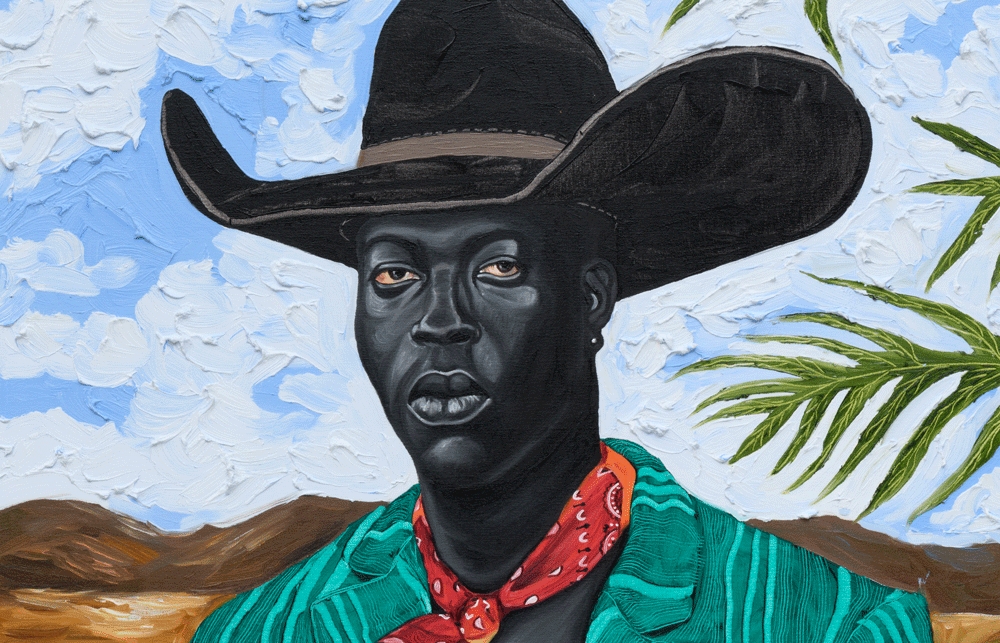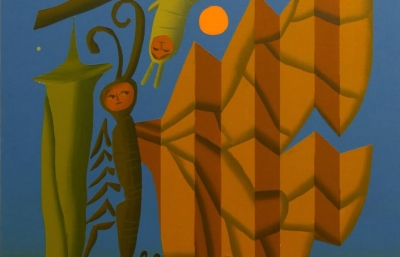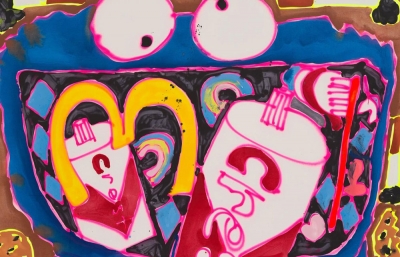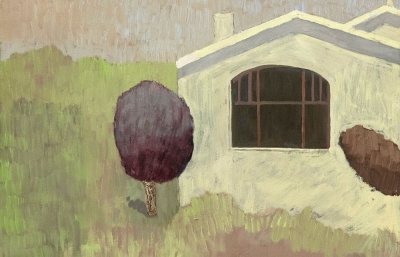Otis Kwame Kye Quaicoe
You're in America
Interview by Shaquille Heath // Portrait by Dan Kvitka
Otis Kwame Kye Quaicoe wants you to feel seen. And I mean that sincerely. It is at the heart of what he does. In every brushstroke, every flower, every mouth covered and eyeball exposed. He is methodical. A powerful narrator, he documents Black life by painting subject’s likeness, enriched with flourishes from his personal memory bank. It is almost historical fiction, yet his instincts are spot on.
After moving to Portland in 2017 from his home in Ghana, Quaicoe was awakened by a baptism in good ol’ American racism, which inspired his first solo exhibition in the U.S., Black Like Me. He aimed to find himself in the richness of Black people around him, to pay tribute to Black existence in a country that actively works to negate it. Showing at Roberts Projects in LA, it may be the only documented kindness bestowed by 2020, finishing its run just a week before the pandemic lockdown. Quaicoe and I spoke at the end of a tireless summer, one which started with righteous black boxes, yet ended with a deluge of lip service. Still, Quaicoe prevails through the stagnation. Regardless of the outcome, he’s found new protest on canvas, and his mission remains the same. No matter how you found him, he’s glad you just might start to understand.
Shaquille Heath: So, Black person to Black person, how are you taking care or finding joy right now?
Otis Kwame Kye Quaicoe: My only joy is just going to the studio. Because when I go to the studio, I just shut the world behind me, and then it’s all about what I’m doing at that moment. And the colors… the brushes, the music. I listen to music from home. It calms me down, and keeps me out of all the craziness that is going on.

Yeah, in this moment, we’re still very much in the midst of this “racial reckoning.” I can’t help but think about how you work actively, with intention, to showcase Black people—almost giving us this dignity that the world still does not allot to us in many ways. I’m wondering, what does it mean for you to portray that right now?
I always say, it doesn’t make any difference because of what is going on now. Since I got here from Ghana, I’ve had a couple of racist experiences. It is one of the reasons why I started mainly with the kind of body of work that I was doing. And, plus, this is something that other artists have been doing for so long. It just only happens that because of what is going on currently, that people are paying attention. They are much more aware… even though they were aware before—but now they are much more aware of how crazy and deep this thing is.
I will also say that, now, it makes people understand what you are working on, even more. So yeah, there’s not been any kind of change, because it is something that I’ve been working on quite a long time. Before all this. But, people get to understand it even more. And they have a clearer picture of what has been going on for a long time.
Have you heard that response from people? That they’re like, “Wow! I get it even deeper now?”
Oh, yeah! A lot of people. Especially with the exhibition I had with Roberts Projects. There are a lot of people who reach out to me and say, “Do you know what? I’m now understanding what that piece meant. And now I understand why you did it.” People will message and tell me that. I’m just glad that they get it now.
I’m curious, since the end of May, have you noticed an influx of what you might say is inauthentic attention?
When all this pandemic happened, all that [Black Lives Matter] started, people reached out to me on Instagram and they were like, “We want to support you! We want to support you! Can you do...” But you know, in some ways, it's kind of like an insult. You know? We’ve been here for a long time. You know, these Black people have been right under your nose. You walk by their shop every day, and you didn’t try to help or try to support them in any way. So the whole thing is like a trend that they are doing. If you want to support, support because you see the potential of the person. Not because there is a thing going on.

I want to recognize that you’ve been in Portland during the pandemic. And, I feel like Portlanders are some of the hardest-going protesters during this entire time. What have you seen or witnessed, and how do you think it’s influenced your art practice?
You know what… what I try to do, sometimes, it’s just too much when you go on the internet, and then you see all that brutality. Sometimes it's too much to carry, right?
For me as an artist, my way of coping with that is to just continue to work more on my subjects. Because... I’m not able to voice out the way other people do. My only way of voicing out is using my brush and paint. So the people that I represent on the canvas must be very powerful. And they must be very commanding when the viewer sees it. That is my way of protesting. The figure has to be as powerful as I would like my voice to be. You know, so... with the protests, it just gives me motivation to work more.
Your show Black Like Me closed right before the pandemic. As an African living within this system, how do you think that American racism has impacted your art practice, if at all?
Oh, it has influenced it majorly. Like I said, when I first arrived here, I arrived with an open mind, Right? With Black crime and police brutality on TV back home, I was like, “Oh! This is going on!” But when you are not here [in America], you don’t understand the full effect of it. So when I got here, the idea was that there was a difference between the African and then the African-American. So, I was thinking that they would treat me in a way that was different than the African-American living here already.
I’ll tell you, one day I woke up in the morning, went outside to exercise a little bit, and I was jogging. And then I realized the police were following me. This police car was following me! So this car would just drive by, and go. So I tried to slow down, and the car also slowed down. I go faster, the car moves faster. And then I realized they were following me, which they did all the way to the park where I went to stretch out. They watched me, and made me know that they were watching me. They stood there, waited as I finished my training, and followed me all the way back to my house. So that kinda, like, triggered me. And I was like, “oh okay…”
So all the little experiences that I had, they were a learning process. It doesn’t matter if you are from Zimbabwe. It doesn’t matter if you are from South Africa. One: you are Black. And if they knew it, you are a target. You are a “dangerous” person. So I start to, you know, have other experiences and then you think, “You know what, it’s time to talk about this.” But how do I talk about it?
I try to find other Black people that are living here. Talk to them. Photograph them. And then try to capture everything that is there in their personality, and put it in a still image.
So when I paint my figures, I try as much as possible to capture their spirit. To capture their emotions. To capture what they want to say, but cannot say, in just one image. So that when you see the figure or the painting, you wonder who the person is. What kind of person? Whether they look so rigid, or so powerful or so emotional or all that. Black Like Me, it’s just me finding myself in any other African-American. Everywhere we go, we are being attacked. So, I put myself in their shoes. And that is one of the reasons why I made it Black Like Me, because no matter where you are from, you are Black. You are in trouble…
You’re in America.
You’re in America. Ha ha!

I've heard you say that all of the subjects in your paintings are telling a story. What comfort do you take in telling a loved one’s story, versus a stranger’s? And does that make the process different?
The process is the same. But, it’s just the emotions that are involved in it that are different when you're dealing with someone you know. When I am painting, I kind of put myself in the realm of the person. You know, when the person is talking to me. How the person feels. I have to put myself in that emotion to be able to get the full idea of who she is, or who he is. To be able to project that on the canvas. ’Cause when you are telling someone's story, or when you are presenting someone to the outside world, you have to get it right. You don’t have to make up something, because you start with the person and speak to the person. So, whenever my figures are involving someone I know or someone I spoke to—when I’m done with it, I show them first. And then when they see, sometimes they are stunned.
I did a portrait of someone recently, a Black mechanic next to my studio. I walked by a few times, and I stopped by to say hi. And I had him stop by the studio once. He came and we had a conversation, and I took a couple of photos of him. And I painted him. And one day, I invited him to come and look at the painting. He came in there and he was speechless! I’ll show you the video. That alone for me… it's just an amazing thing.
The ones that I paint out from my head, that’s my own way of adding my own story. My own experience. I’m not using my face, but trying to create images of different people I've seen when I’m walking around. Facial expressions, shapes… so that is where I put my own experience. Black people who I couldn’t talk to. The pieces are kind of like a collage. Just different pieces that I put together to talk about my kind of people. So, the process is the same, but the approach and the emotion are different.
How do you choose what story of theirs to tell? Or are you telling multiple stories when painting?
First, when I approach them, I listen to their story to know about them, and what’s going on in their lives. Once you know that, you have an idea of how to approach the work. And then, I add my life to it. My additions are when it comes to the fashions and the surroundings—what I add to the background. So, it’s a combination of both stories.
The main story from the outside is capturing the emotions and the person's spirit. Who the person is. And then I add the dressing. You know how we Black people dress! You know how we want to stand out as people. We dress in a statement way. We want to look so powerful! So I add all those kinds of things. Things you see when you walk into a Black neighborhood. Things that make us unique.

One piece that I love is called Steady Gaze. And I think about it particularly right now, because his mouth is covered—you can just see his nose. Oh, and his eye! There’s a way that his eye is looking at you. I feel like it’s a representation of all of the things that we can see, as well as all of the things that we can’t, when it comes to our emotions in this year.
And that’s some of the things when it comes to these little details in my cowboy series. It’s like, I told somebody, “America, they tell you, land of the free. You live free.” We are free… but we are not free. That is the thing. As a Black person growing up in a Black community or Black family, I’m taught how to speak in a certain way in the midst of one people. So, it’s like, you do all the coaching and emotions just with your eyes. You just have to be constantly looking around when you go to places. Just like me. When I go out, I have to look around constantly. I have to be aware of where I’m going. To be aware of the people who are around me and all that, ya know. So, I don't like when I cover their mouth. It's just all the silence. The things that we want to say, but we cannot because it might get us killed, or get us arrested, or get us in trouble. So we kind of do all of our talking with our eyes.
I walked into a grocery shop, and people stared at me in a weird way. And all I can do is just stand back. It’s just like… we are communicating with silence. It's very powerful in a way. There’s this thing going on, but we cannot say. All because of what is going on.
Something that I’ve noticed walking around, particularly when I’m meeting eyes with another Black person… you know before, there was always the acknowledgement of, “seeing another Black person.” It’s always like, “Hey! There you are! You exist too!”
[Laughing] Haha, so true, so true!
But now it’s almost like… it’s even a deeper love—when I’m connecting eyes with another Black person right now.
Yeah! Even when I go to Chicago, I walk around the street and they nod the head, or they wink or something. You know there is something deeper. It’s kind of like saying “I got you!” I got your back, you got my back… that kind of thing.
Like I said, I always have most of my experiences at the grocery shop. I was in line, at the checkout, and this Black person tapped on my shirt and said, “I’m glad I’m not the only Black person here.” And I turned around and we smiled at each other, and then we just went on. It’s just so crazy sometimes when you think about it. It might look little, but it’s a really big thing.
@otis_quaicoe // This interview was originally published in the Winter 2021 Quarterly
Images courtesy of Roberts Projects
Images courtesy of Roberts Projects






